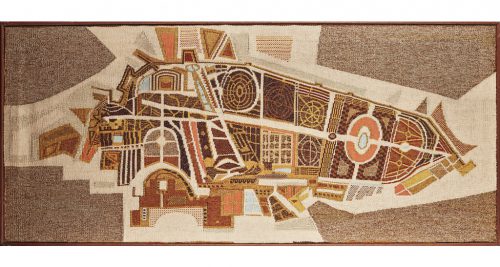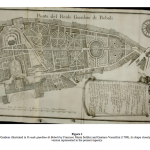11283 WOOLWORK TAPESTRY PANEL ENTITLED BOBOLI I BY ARCHIE BRENNAN (B. 1931) FOR EDINBURGH WEAVERS Dated 1963. Measurements: Height: 26″ (66 cm) Width: 59″ (150 cm).

Research
Of wool and lurex thread. Depicting an abstract aerial plan of the Boboli gardens, Florence, Italy.
Marks:
Exhibition label to the reverse:
The Scottish Arts Council
Archie Brennan Tapestry
3 Boboli I 1963
24 X 60 Tapestry
Mr. Frank Laycock
Exhibited:
Edinburgh, Scottish Arts Council
This interesting wool tapestry depicts a rather abstract aerial plan of the Boboli Gardens of Florence, Italy and was woven in 1963 by Scottish artist Archie Brennan (b. 1931).
Archie Brennan was born in Roslin, Scotland, near Edinburgh. He began drawing and painting as a young man, and at the age of 15 enrolled in drawing courses at the local art school. It was here that he was introduced to the Dovecot tapestry studio, whose apprentices were also attending the classes. Dovecot had been established in 1912 by the Marquess of Bute and in 1946 was incorporated officially as Edinburgh Tapestry Company. Two years later Brennan joined the apprentices at Dovecot, beginning his career in the tapestry arts. His apprenticeship lasted until 1954, followed by a period of travel and study in France. His postgraduate studies were carried out at the Edinburgh College of Art between 1958 and 1962, after which Brennan established the Graduate and Post Graduate Department of Tapestry and Fibre Arts at the college. His work at Dovecot continued as he assumed the position of director in 1963. Brennan spent time teaching, consulting and working on his own tapestry in Australia and Papua New Guinea in the 1970s and Hawaii in the 1980s. Since 1993 he has been established in New York where he continues to teach and focus on his own weaving projects.
The Boboli Gardens represent some of the first formal 16th century Italian gardens, laid out on a hill beside the Palazzo Pitti, seat of the Medici family of Grand Dukes in Florence. The Palazzo was purchased in 1549 by Cosimo I de´ Medici and his wife Eleonora di Toledo and expanded under the direction of the art historian Giorgio Vasari. The original landscape architect employed for the gardens was Niccolò Tribolo. He died the following year however, in 1550, and was replaced by Bartolommeo Ammananti; additional projects were carried out by Vasari, Giulio Parigi, and Bernardo Buontalenti.
The park has a central axis surrounded by avenues, terraces and hedges, and is adorned throughout with 16th-18th century sculpture, fountains, amphitheatre, garden temples, and an impressive grotto. An 18th century description of the Boboli Gardens, with accompanying illustrations of its statuary, was published in Il reale giardino di Boboli by Francsco Maria Soldini and Gaetano Vascellini (1789). The book also includes a plan of the park (figure 1), its shape closely related to the modern version represented in the present tapestry.


Comments are closed.